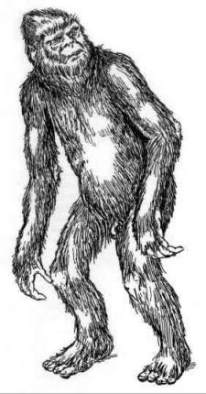
June 8, 2008

A group of scientists from the UK based Centre for Fortean Zoology are set to travel to the Caucasus Mountains of the Southwest Russian republic of Karbadino Balkaria in search of what they are saying may be “mankind’s closest living relative ~ a hominid known as the almasty.”
The three-week expedition is being filmed by October Films for UK Channel 4 television, and by the team themselves for a feature length documentary to be broadcast, for free, on their CFZtv multimedia website.
Ukrainian biologist Grigory Panchenko, who has been on the track of the ape-like man for over 14 years, will join the five-man team. Panchenko has seen the creature on four occasions including “a hair-rising encounter on a remote farm, when he got to within ten feet of the creature.”

Harry Trumbore’s drawing of an Almas in The Field Guide to Bigfoot and Other Mystery Primates (NY: Anomalist Books, 2006).
Zoological director of the Centre for Fortean Zoology, Richard Freeman, 38, considers the creatures to be large, primitive descendants of Homo erectus:
“Homo erectus was the ancestor of not only modern man but the Neanderthal and the tiny, recently discovered Homo floresiensis. There is no reason why it should not have had other descendants. The almasty is described as large, hairy and powerful. It is smaller and more human in appearance than the better-known yeti of the Himalayas. It has no fire and only rudimentary, ape-like tool use. Grigory Panchenko believes that it is on the increase in the Karbadino Balkeria area of the Caucasus. There are many more reports here than in other areas and also reports of family groups.”

[Please note, Freeman’s theorizing may be a little shaky, as Homo erectus have been found, in some cases, to be contemporaries of the other hominid species he mentions, the affinities he notes are outside of current thought, and, indeed, the old-fashioned single-species-evolving-into-the-next-species theory has been mostly discarded. Almas may be Homo erectus but their implied relationship as our “ancestors” is misleading and unimportant in this quest. I fully support this expedition, on the grounds that obtaining unbiased data is the best avenue for determining the nature of these hominoids. – LC]
 The team are also working with Professor Bryan Sykes, Professor of Human Genetics at the University of Oxford and a Fellow of Wolfson College. Sykes is best known outside the community of geneticists for his bestselling books The Seven Daughters of Eve, and Blood of the Isles: Exploring the Genetic Roots of Our Tribal History which describe the investigation of human history and prehistory through studies of mitochondrial DNA. Because all the stories of the almasty insist that these creatures can, and do, interbreed with humans, the team will be taking DNA samples from a wide range of people in Karbadino Balkaria, and Professor Sykes hopes that through mitochondrial DNA analysis the true identity of the almasty will be discovered.
The team are also working with Professor Bryan Sykes, Professor of Human Genetics at the University of Oxford and a Fellow of Wolfson College. Sykes is best known outside the community of geneticists for his bestselling books The Seven Daughters of Eve, and Blood of the Isles: Exploring the Genetic Roots of Our Tribal History which describe the investigation of human history and prehistory through studies of mitochondrial DNA. Because all the stories of the almasty insist that these creatures can, and do, interbreed with humans, the team will be taking DNA samples from a wide range of people in Karbadino Balkaria, and Professor Sykes hopes that through mitochondrial DNA analysis the true identity of the almasty will be discovered.
The three-week expedition leaves the UK on June the 21st and will be employing camera traps in the hope of photographing one of these creatures as well as interviewing witnesses and exploring the areas were the almasty has been sighted. An ongoing blog will be written by members of the expedition.
The CFZ team will also be investigating reports of a huge species of snake, some thirty feet long, said to inhabit the mountains. The size of a large python, it is far bigger than any species known to inhabit the area.
About Loren Coleman
Loren Coleman is one of the world’s leading cryptozoologists, some say “the” leading living cryptozoologist. Certainly, he is acknowledged as the current living American researcher and writer who has most popularized cryptozoology in the late 20th and early 21st centuries.
Starting his fieldwork and investigations in 1960, after traveling and trekking extensively in pursuit of cryptozoological mysteries, Coleman began writing to share his experiences in 1969. An honorary member of Ivan T. Sanderson’s Society for the Investigation of the Unexplained in the 1970s, Coleman has been bestowed with similar honorary memberships of the North Idaho College Cryptozoology Club in 1983, and in subsequent years, that of the British Columbia Scientific Cryptozoology Club, CryptoSafari International, and other international organizations. He was also a Life Member and Benefactor of the International Society of Cryptozoology (now-defunct).
Loren Coleman’s daily blog, as a member of the Cryptomundo Team, served as an ongoing avenue of communication for the ever-growing body of cryptozoo news from 2005 through 2013. He returned as an infrequent contributor beginning Halloween week of 2015.
Coleman is the founder in 2003, and current director of the International Cryptozoology Museum in Portland, Maine.
Filed under Almas, Breaking News, Cryptotourism, CryptoZoo News, Cryptozoologists, Cryptozoology, Expedition Reports